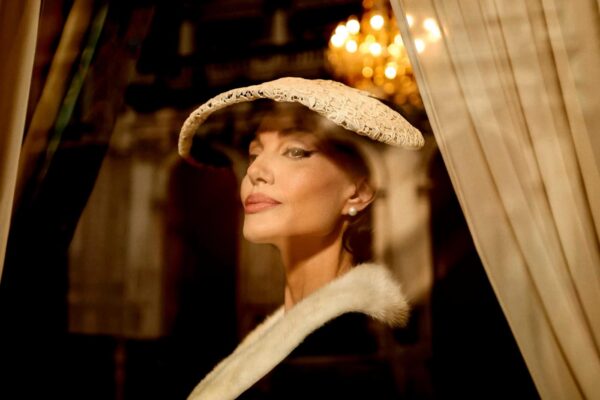Film Review: “Maria” — A Convincing Portrait of a Woman Consumed by the Art That Nourished Her
By Jon Garelick
This might not be everybody’s idea of who Maria Callas was, but the film is plausible, and honest. You can watch Angelina Jolie’s Maria and think, so that’s what it was like to be her.
Maria, directed by Pablo Larraín. Streaming on Netflix.

Angelina Jolie plays Maria Callas in Netflix’s Maria. Photo: Vision Distribution
The first thing you notice about Angelina Jolie’s performance in Maria is the voice. Not the singing voice — the speaking voice. Here not only is the deep timbre, but also the cadences, the lofty pronouncements on art and life, delivered with the kind of aristocratic flourish familiar to fans of opera icon Maria Callas from countless TV interviews and documentaries.
After news clips of Callas the celebrity, we get a tight closeup of “Maria” singing — looking very much like the real thing, until you realize it’s not. The voice here — “Ave Maria” from Verdi’s Otello – is Callas’s, from a recording. Jolie reportedly took operatic vocal training for seven months, and her lip-synched performances alternate with what appears to be Jolie approximating late-period Callas — the dark colorings, the vocal commitment, the threadbare patchiness — in scenes of Maria rehearsing for a comeback that never happens.
There are plenty of points where one can quibble with the biographical accuracy of Maria — it is, after all, not a documentary but a work of fiction. Did Callas’s mother really pimp her out to Nazi soldiers in Athens during World War II? (No, but she tried, and the soldiers were occupying Italians, not Germans.) Did Callas visit her estranged lover Aristotle Onassis on his deathbed? (Possibly.) Did Callas really have a housemaid named Bruna and a butler/chauffeur named Ferruccio? (Yes.) You can verify or reject these and any number of biographical “facts” by consulting Sophia Lambton’s exhaustive 2023 biography, The Callas Imprint. (You can find Ralph P. Locke’s “Short Fuse” review of the book here.)
But as a friend of mine complained about a particularly fussy review of director Taylor Hackford’s Ray Charles biopic Ray (2003), “I don’t want to know if it’s correct. I want to know if it’s any good.”
The simple answer: Yes, it’s good. Much of the film’s success is due to Jolie’s Callas-like commitment, but Pablo Larraín’s direction also gives Jolie’s lived-in performance the right mise en scène.
If you know Larraín’s previous films about famous women — Spencer (2021), about Princess Diana, with a screenplay by Maria writer Steven Knight, and Jackie (2016), about Jacqueline Kennedy — you know his approach tends toward the impressionistic.
Maria opens with Callas’s death, September 16, 1977, at 53, of a heart attack in her Paris apartment. In fact, she’s already dead, on the floor under a white sheet, with police, EMTs, and Bruna and Ferruccio in attendance. From there it focuses on the last week of Callas’s life, her rehearsals in an empty theater with an accompanist as she attempts to get her voice back in shape, her forays into the city for a trip to a restaurant, her sessions with a documentary film crew.
There are a number of scenes that could be “really” happening or merely dreamscape imaginings as Maria doses herself with sleeping pills and possibly other drugs and complains of hallucinations. (“What is real and what is not real is my business,” Maria says at one point.) Sections of the film are introduced with film clapperboards (“Act I: The Diva”), and when Maria ventures into Paris her inner monologue at one point is answered by a crowd of Parisians on a square singing Verdi’s “Anvil Chorus” from Il Trovatore. At times when Maria is parrying questions from the documentary director you begin to get the sense that this film is actually the film we’re watching. It’s also telling that the name of the director (played by Kodi Smit-McPhee) is the name of the sleep aid she’s been taking, Mandrax.
The scenes where Maria spars with the long-suffering Bruna (Alba Rohrwacher) and Ferruccio (Pierfrancesco Favino) have almost comic tenderness — as when Maria asks Ferruccio to move, for the umpteenth time, her grand piano from one room of her palatial, high-ceilinged apartment to another. You can read this as the controlling diva asserting command of her stage set or as a dying woman rearranging deck furniture on the Titanic. Maria tries out an aria on Bruna as the latter noisily fries and flips a sizzling omelet. When Callas asks, “So?,” the cook answers, cautiously, “It was … magnificent.”
Street scenes are shot in bright sunlit cityscapes of brown stone and blue sky. Shifts from the present to Callas’s triumphs in opera houses in Milan and Venice can be breathtaking, informed by the real Callas’s recordings of Puccini’s Tosca, Donizetti’s Anna Bolena, or Bellini’s Norma, Jolie conveying the commanding stage presence. And you couldn’t ask for a better soundtrack: Verdi, Donizetti, Bellini, Puccini.
Among the supporting cast, Haluk Bilginer is especially good as Onassis, a charming seducer, a latter-day commander of a Greek fleet, a robber baron proud of his own thievery, showing off his classical museum pieces to Maria, the one flesh-and-blood goddess he truly adores (for now). A quip on his deathbed about his marriage to Jackie is one of the film’s great laugh lines.
So what kind of Callas does Maria leave us with? Pill-popping diva? Is she another filmic Norma Desmond, alone with her memories? Is she Anna Bolena, awaiting the bloody chop? Verdi’s Violetta, both celebrated and shunned, feeling one last surge of life before the inevitable (“Rinasce!”)?
The only real test of fictional cinematic biographies is our belief in the invented character — Ed Harris as Jackson Pollock, Bruno Ganz as Hitler, James Cagney as George M. Cohan, to name a few great ones. It should leave you with the thought: So that’s what it was like to be him. In Jolie and Larraín’s Maria, we get a convincing portrait of a woman consumed by the art that nourished her. So the defining, ultimate aria comes from Puccini’s Floria Tosca, “Visse d’arte.” “I lived for art.”
This might not be everybody’s idea of who Maria Callas was, but it’s plausible, and honest. You can watch Jolie’s Maria and think, so that’s what it was like to be her.
Jon Garelick can be reached at garelickjon@gmail.com.

A real piece of art and the “Performance of the Year” by the beautiful, smart, and very gifted Angelina Jolie. At 49 years of age Angelina has excelled in front of as well as behind the camera. This kind of consistent success for these years deserves a commanding celebration.Get real Hollywood: Maria is brilliantly directed by Pablo Larrain and to Angelina — BRAVO, BRAVO, BRAVO!!!!!☆☆☆☆☆☆☆☆☆
I felt Maria Callas’ pain and despair throughout that last week of her life through Angelina’s heartfelt acting. I thought she reached her full potential to be Maria. She was outstanding. I cried throughout the whole movie. I cried not because of Angelina’s acting, but for Maria. Angelina embodied Maria’s soul to show that she was still the diva and to show the people that she was still the greatest soprano to ever lived. The movie also showed her vulnerability, how to love and care for others. Yes, she learned to be her own person, but a little too late. Angelina portrait her love and care. Another Oscars nomination.